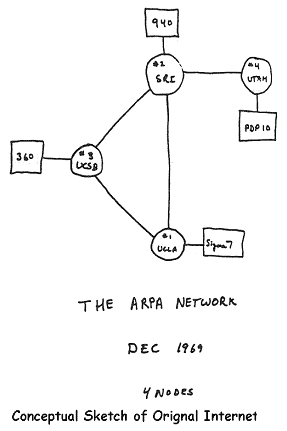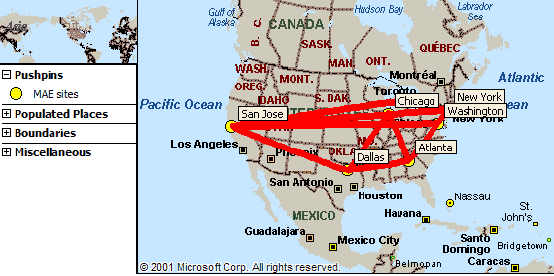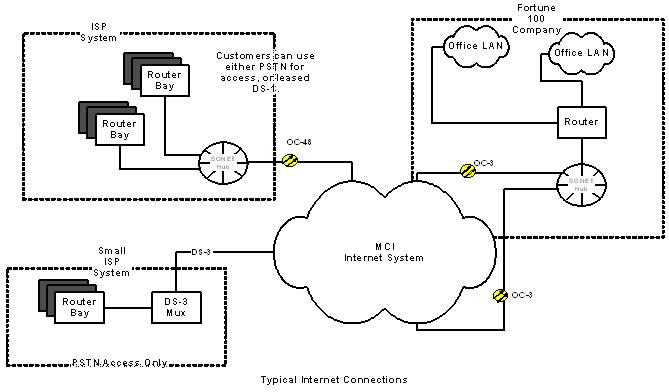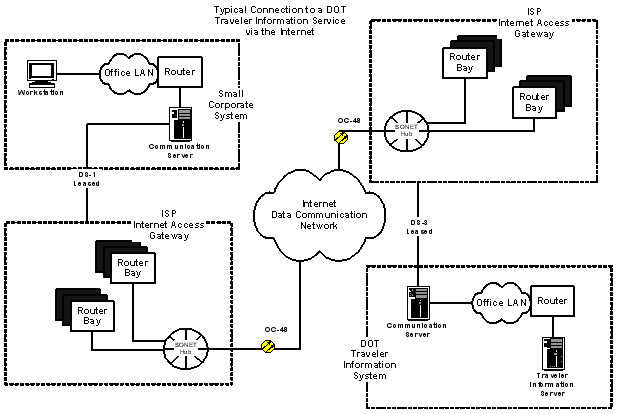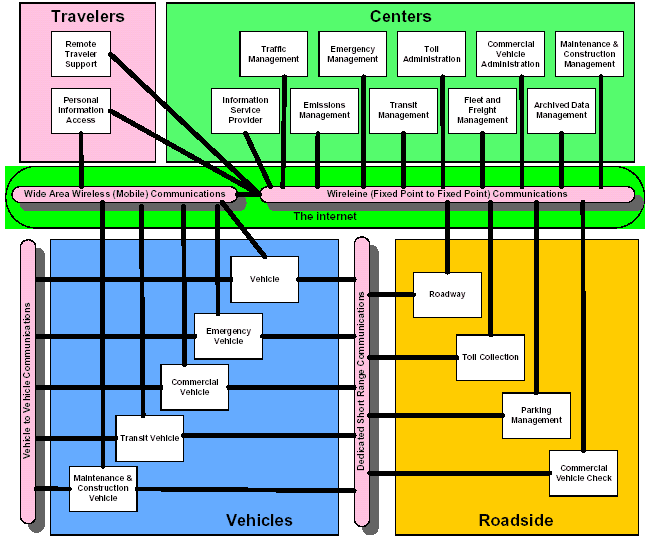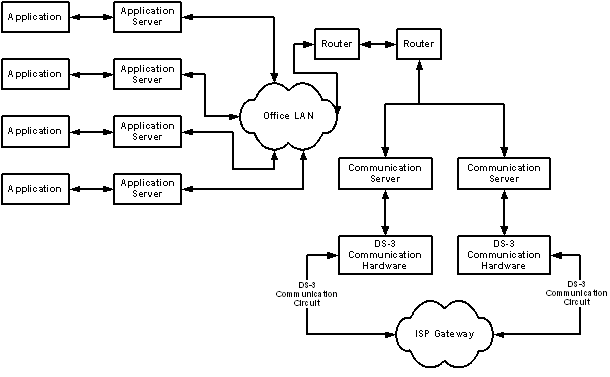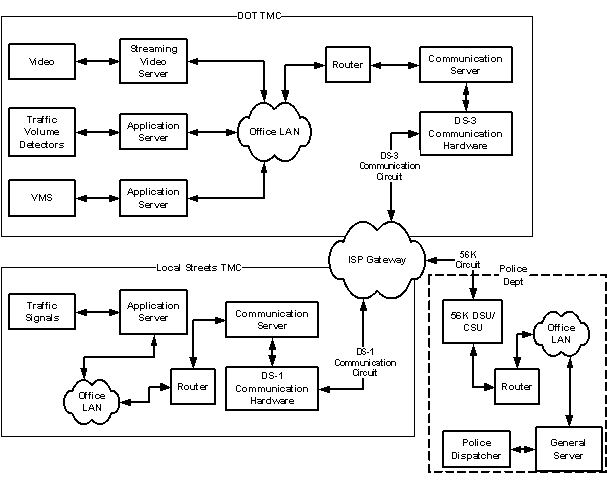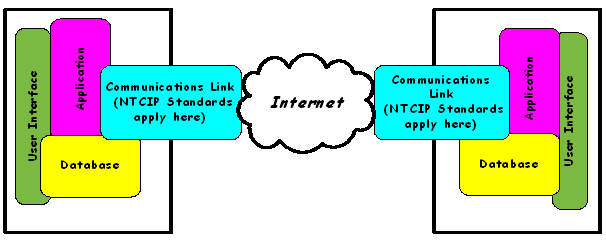Chapter 9. The Internet
Introduction
The internet is a major communication tool used by commercial enterprise, and government agencies to support trade, operations, and interaction with customers and suppliers. Many individuals use the internet every day, at work and at home. Throughout the world, the internet is used as a primary source of communication and information services. In fact, the International Telecommunications Union (ITU) estimates that, as of 2002, more than 650 million individuals, worldwide, use the internet. A Harris Poll Survey, in January 2004, revealed that 146 million adults in the United States use the Internet, and 37% have access to broadband connections. In this chapter, you will learn about the Internet's structure, how it works, and its history. The chapter will also look at how transportation agencies use the internet to provide information and facilitate interaction with other government agencies. Consistent with the other chapters in this Handbook, the information presented is basic and designed to provide an elementary understanding of the internet and communication requirements.
What Is the Internet?
The Internet is an international network of computers connected by wires such as telephone lines. Schools, businesses, government offices, and many homes use the Internet to communicate with one another. You probably have access to the Internet via a computer at work, and may have access from your home computer. Many have access via their cell phone, and soon, you may have access via an embedded device in your automobile.
The term "World-Wide-Web" is a verbal description of the image presented by the interconnecting communication links between the network nodes – it appears to emulate a spider web. |
Gaining access is simple. A computer, modem, telephone line, an account with an Internet Service Provider (ISP), and web browser software, is all that's necessary. Most individuals and businesses pay for internet access, but there are also a number of providers that will permit access without fees.
The most popular component of the Internet is electronic mail (e-mail). The use of e-mail has changed the way in which individuals, corporations and government agencies communicate. E-mail allows for the almost instant delivery of information, and has caused a reduction in the use of voice communication via the telephone. In general, the use of e-mail is becoming a universal tool for communication.
Organizations and individuals are able to create web sites to post information about their products, services, and themselves. Departments of transportation post information about roadway maintenance, traffic congestion, and other traveler information on their websites.
History of the Internet
The Internet evolved from a network developed originally to support scientific research to the "World Wide Web" (WWW) over a period of 40 years. In the early 1960's, the United States Department of Defense (DOD) created the Advanced Research Projects Agency (ARPA). One of its first projects was to create a system to link research centers and Universities for purposes of sharing information (13).
Today, it is a worldwide operation consisting of millions of computers and computer networks. A public, voluntary, and cooperative effort between the connected institutions and not owned or operated by any single organization. The underlying infrastructure is, however, owned and operated by a number of telecommunication companies.
The Internet and Transmission Control Protocols were initially developed in 1973 by American computer scientist Vinton Cerf as part of a project sponsored by the United States Department of Defense Advanced Research Projects Agency (DARPA) and directed by American engineer Robert Kahn.
Internet technology was a primitive precursor of the Information Superhighway, with the goal of computer communications to provide schools, libraries, businesses, and homes universal access to quality information that will educate, inform, and entertain. The original demonstration project was small and consisted of four nodes. Each node provided a combination of processing and network connectivity capability. The current system has a combination of generalized nodes and specialized nodes providing different types of support for the world-wide-web.
The Internet and the World-Wide-Web
The average individual did not become aware of the internet until the mid-1990s. It was basically the province of scientists and university researchers and a few computer "geeks" able to understand how computer networks and software functioned to allow this type of communication. Not until the introduction of graphical user interfaces (GUI) and the innovations of companies (CompuServe, America-On-Line and others long forgotten) wanting to popularize and commercialize the process did the internet evolve into the "world-wide-web" (WWW). America-on-Line (AOL) introduced a user friendly graphical interface, in 1994, which made it easy for a person with limited computer skills to access (or browse) and use the internet. Other companies soon followed the example with their own proprietary web interfaces. These interfaces are commonly referred to as "Web Browsers". Originally, a user had to enter a specific destination code (more later). The new GUI interface systems provided the less experienced internet user with a way to simply "browse" web pages as if they were reading a magazine.
The World Wide Web is a network that links computers together via a world wide communication network. The communication network is composed of a hierarchy of nodes, linked via an infrastructure of fiber optic, copper, and wireless communication facilities. This is sometimes referred to as the "Infostructure".
The nodes are owned and operated by companies that are in business to provide a service to other companies that provide internet access to businesses and individuals. A subsidiary of MCI operates major internet switching nodes in the United States.
This map (figure 9-3) shows the location of the primary internet switching points in the United States. These nodes are owned and operated by a subsidiary of MCI.
These nodes are interconnected to efficiently manage internet traffic and prevent "bottle-necks". They are connected via a series of survivable fiber optic (chapter 2) communication rings. Nodes in the United States are connected to other nodes in Europe and Asia to support a world wide web of internet systems.
Internet nodes can be very large and be spread over several buildings, or very small occupying only enough space to house several small computers. The MCI MAE-East facility is located on Long Island, but is supported by a number of alternate nodes spread throughout the New York City metro area. Major internet service providers, such as AOL, AT&T WorldNet, MSN, and Yahoo have major access points located in close proximity (same building, or within a few blocks) of the MCI facilities. This allows these major ISPs to provide a large number of users efficient access to the internet. Major ISPs have multiple high bandwidth links (OC-192 or 10 GB) to the MCI nodes. This is also true for the major telecommunication carriers such as Sprint, Verizon, SBC QWEST, AT&T, etc. These companies are considered as Tier One carriers. All other providers access the internet via one of the Tier One carriers.
Departments of transportation using the internet will contract with a service provider (Internet Service Provider) for access. The ISP will arrange for all necessary communication connections, access servers, webmaster support, and help desk to trouble shoot problems. Later in this chapter internet connection and setup options will be discussed. All ISPs provide similar services:
- Communication connectivity to Carriers.
- Routers to direct internet traffic
- Switches to create virtual communication paths
- Computers to support internet traffic.
- An electrically protected environment for computing and communication equipment.
- Shared floor space for companies to place equipment for internet access.
- Modem banks for dial-up access
The following diagram (figure 9-3) shows a typical set of connections for ISP and large corporate users to access the internet. Notice that the large corporate user has installed a redundant communication link to the internet. Internet Service Providers may also install redundant links, or they may have a distributed network that provides redundancy without the need for duplicate communication links. The drawing shows SONET hubs and SONET broadband communication links. Once standards are fully implemented, this architecture will most likely change to Gigabit Ethernet hubs (or switches) with 10 GigE/GigE communication links.
The use of redundant links serves two purposes. First, the need to maintain a connection for services. Second, redundant links can also be used to support temporary requirements for increased capacity. Traveler information systems (ATIS) may become overloaded during a major incident. The primary communication link may not be able to provide adequate throughput, and the redundant link is used to temporarily share the load. Most broadband communication links provide service for both voice and data and TMCs have both center-to-center and center-to-public requirements. Later sections in this chapter provide more information about how Transportation Management Centers can use the internet or internet like services to fulfill "mission critical" requirements.
How Does the Internet Work?
Two primary elements make the internet work. First, the internet is built as an overlay to the world wide telecommunications infrastructure. Portions of the network were specially built to meet the needs of the internet. However, most of the communication network is based on the use of the common infrastructure. Second, there is a common set of communication protocols and an agreed set of standards for the software language used by web browsers. This commonality permits a person in Japan to view web pages created in France.
The Internet – or the World-Wide-Web – is formed by connecting local networks through special computers in each network known as gateways. Interconnections are made through various communication paths, including telephone lines, optical fibers, and radio links. The connections between the main gateways are permanent; however, the connections for individual users (at home, or the office) are setup as needed. Additional networks can be added by linking to new gateways. Information to be delivered to a remote machine is tagged with the computerized address of that particular machine. The following diagram (figure 9-4) is a schematic of how an individual in a small corporate office might obtain traffic congestion information via the internet. Notice that only the ISP is directly connected to the internet system. All other users are routed to the internet via the PSTN or leased lines from an intermediate communication carrier.
The DOT must enter into agreements with both the ISP and a carrier to be able to provide traveler information services via the internet. An alternative solution is available. The ISP provides all of the services and systems as part of a package. However, the DOT can provide its own services. This would require developing a network of internet servers and routers. The DOT would have to duplicate the systems and services that it obtains from an ISP. The decision to do this is based on economic and organizational requirements.
In the example above, the connections are all permanent by virtue of the high speed leased lines. However, if users at home wanted to access the DOT Traveler Information web pages, their connection would be temporary. The network would be created on an "ad hoc" basis. As soon as the home user logged-off, the connections would go away.
Addressing – Formats
Various addressing formats are used by the different services provided by internets. Addressing is similar to a telephone number – it lets the system know which web site you want to visit.
One format is known as dotted decimal, for example: 123.45.67.89. Another format describes the name of the destination computer and other routing information, such as "machine.dept.univ.edu." The suffix at the end of the internet address designates the type of organization that owns the particular computer network, for example, educational institutions (.edu), military locations (.mil), government offices (.gov), and non-profit organizations (.org). Networks outside the United States use suffixes that indicate the country, for example (.ca) for Canada. A (.us) suffix is now available for the United States.
Once addressed, the information leaves its home network through a gateway. It is routed from gateway to gateway until it reaches the local network containing the destination machine. Internets have no central control, that is, no single computer directs the flow of information. This routing is referred to as the Internet Protocol (IP). This protocol specifies how gateway machines route information from the sending computer to the recipient computer. Another protocol, Transmission Control Protocol (TCP), checks whether the information has arrived at the destination computer and, if not, causes the information to be resent. The overall protocol is referred to as TCP/IP – Transmission Control Protocol/Internet Protocol.
To support a diverse set of users across the Internet, it is important to use a technology that is independent of a computing platform so that any network device can access the web service. Such a technology should be compact using little bandwidth and very portable so it can be used on many devices. There are several very powerful languages and protocols that are used between disparate systems located on the Internet, such as:
- Extensible Markup Language (XML)
- Simple Object Access Protocol (SOAP)
- Java
Extensible Markup Language
XML was created during the mid to late 90s as a way to take raw data such as text, graphics, or binary transmissions from nearly any source and apply an organizational structure that is both contextual and visual. XML can be used to deliver structured content including text, vector graphics, and electronic transactions across a network like the Internet.
Simple Object Access Protocol
SOAP follows the typical client/server model and is designed to use standard technologies like XML to transmit small amounts of information across a network using a standardized language and format. SOAP does not use any specific transport protocol and does not use any programming model. It is a language that can be used to send commands and information as well as a standardized method of organizing and encoding information. Because SOAP is independent of transport protocol and programming model, it is well suited for communication between systems that would not otherwise be able to communicate. Therefore, a SOAP-aware application is able to create, send, receive, and interpret the commands between disparate systems and act upon them as intended.
Java
A programming language that is designed to be platform-independent and portable. In other words, Java is not based on a specific computing platform; it is based on its own workspace, which can exist in any computing environment. Java applications can operate exactly the same on any computer regardless of the operating system or hardware configuration used. Java creates a self-contained computing environment that can run within other operating systems and interact with an operating system to perform tasks. Java consists of three major components:
- Java programming language
- Java application libraries
- Java virtual machine
Each of these technologies is used in some capacity to deliver web services. However, the World Wide Web Consortium (W3C) is beginning to standardize which protocol should be used when delivering web services. In a working draft created in May 2003 called Web Services Architecture, the W3C outlines the core technologies behind a web service and gives some guidelines on how the service should be developed, designed, and deployed. The W3C seems to have agreed upon XML as the basis for a standardized web service, but only time will tell which language will be chosen. More than likely there will still be a variety of languages used to create web services, even after a standard has been established.
For more information see: Web Services Architecture – (http://www.w3.org/TR/ws-arch/) – W3C Working Draft May 14, 2003.
Computer interaction has dramatically changed our world, bridging the barriers of time and distance, allowing people to share information and work together. Evolution of the Information Superhighway is continuing at an accelerating rate. The available content has grown at a rapid pace, and will continue growing rapidly, making it easier to find any information on the Internet. All Government Agencies, Universities, and virtually all commercial enterprises use the internet as a primary means of providing information to the public. New applications provide secure business transactions and new opportunities for commerce. New technologies continue to increase the speed of information transfer. Internet users are now able to download feature length movies and Broadway Shows.
Types of Internet Networks
There are several different configurations of internets. Most common is the Internet used by millions every day. The system is open to anyone with a modem, telephone line, and a web browser. Companies, government agencies, schools and other organizations have discovered that the simple common internet protocols can be used to create a very powerful internal communication network. Setting up an internal internet provides organizations with the ability to communicate using the same software and systems used for external communications.
Intra-Net
These networks are called "Intra-Net". They are only accessible by individuals directly connected via a local area network. Most users are familiar with the PSTN version that allows access via a standard telephone line connection using a modem. Access can also be gained via cable TV system links, broadband DSL links, and direct connections via DS-1 or DS-3 links. Intra-Nets are private networks contained within an enterprise. It may consist of many interlinked local area networks and also use leased lines in the Wide Area Network. Typically, an intranet includes connections through one or more gateway computers to the outside Internet. The main purpose of an intranet is to share company information and computing resources among employees. An intranet can also be used to facilitate working in groups and for teleconferences. An intranet uses TCP/IP, HTTP, and other Internet protocols and in general looks like a private version of the Internet. With tunneling, companies can send private messages through the public network, using the public network with special encryption/decryption and other security safeguards to connect one part of their intranet to another. Typically, larger enterprises allow users within their intranet to access the public Internet through firewall servers that have the ability to screen messages in both directions so that company security is maintained.
Extra-Net
An extranet is created when part of an intranet is made accessible to customers, partners, suppliers, or others outside the organization. A DOT could create an extranet to share information with incident responders. Local police departments could be provided with images from CCTV cameras to support coordinated management of a specific incident.
An Extra-Net is a private network that uses the Internet protocol and the public telecommunication system to securely share part of a business's information or operations with suppliers, vendors, partners, customers, or other businesses. An extranet can be viewed as part of a company's intranet that is extended to users outside the company. It has also been described as a "state of mind" in which the Internet is perceived as a way to do business with other companies as well as to sell products to customers.
An extranet requires security and privacy. They require firewall server management, the issuance and use of digital certificates or similar means of user authentication, encryption of messages, and the use of virtual private networks (VPN) that tunnel through the public network. Companies can use an extranet to:
- Exchange large volumes of data using Electronic Data Interchange (EDI)
- Share product catalogs exclusively with wholesalers or those "in the trade"
- Collaborate with other companies on joint development efforts
- Jointly develop and use training programs with other companies
- Provide or access services provided by one company to a group of other companies, such as an online banking application managed by one company on behalf of affiliated banks
- Share news of common interest exclusively with partner companies
Role of the Internet for Traffic, ITS, Freeway Management, & Traveler Information
If the Internet was viewed from the perspective of the National Architecture, it would be shown as a communication element. The architecture model might be modified showing the Internet as an underlying element of wide area wireless and wire line communications systems.
Departments of transportation have looked to the internet as a way to communicate with the traveling public. The Web is primarily used to provide information about current travel conditions, including:
- Locations of congestion
- Video views of highway sections
- Video views of intersections
- Highway segment travel times
- Construction locations and possible travel times
- Special events
- Weather conditions affecting travel
- Link to other transportation agencies
- Link to Department of Motor Vehicle services
Examples of current internet sites
- Virginia Department of Transportation: http://virginiadot.org/default_myvdot.asp
- Kansas Department of Transportation: http://www.ksdot.org/
- California Department of Transportation: http://www.dot.ca.gov/
The above are a few examples of DOT web sites. More can be found at the following resource web site: http://www.betterroads.com/linkspages/linksdot.htm. Better Roads is a publication of James Informational Media, Inc.
Many DOT sites provide a significant amount of traveler information in a traditional WWW access mode. Some sites provide access to driver license and automobile registration via secure links. Others even provide access for trucking firms to file for travel permits. This is all accomplished through the use of secure web pages that allow users to complete a financial transaction on-line. Many of these sites require the user to complete an application for secure access to the financial transaction web pages. However, the telecommunication portion of the system has no impact on the overall transaction. It is in fact, transparent, and simply provides the connection between service provider and customer.
Use of the Internet for Center-to-Center Communications
The internet can be used as a telecommunication tool to allow transportation agencies to provide for a more efficient operation. In addition to providing access for the public to obtain services and receive information, it can be used to help support secure, efficient "Center-to-Center" communication links. Using a combination of internets, intranets, and extra-nets, agency-to-agency links are easy to accomplish.
To better understand the role of the internet and its various telecommunications applications, let's look at the basic elements needed (table 9-1), and a schematic. The elements (from a telecommunication perspective) are as follows:
The above table and schematic (figure 9-6) show how a typical DOT system may connect to the internet. However, there are several variations.
Some DOTs may have contracted their system to a company that provides all of the necessary application servers and communication pathways. In that case, the DOT would have remote access to the system to provide updates and additions. The contract with the private company would include all necessary services, including periodic maintenance and equipment updates. Overall design of an internet system is normally handled by a specialist using support from the Information Technology Department (IT), the ISP, and the carrier providing the leased communication facility.
A virtual permanent connection – "VPC" – is communication path that is permanently in place, but is not a fixed communication link such as a T-1. The communication path is always available and private, but does not always take the same route between two points; therefore, it is "virtual". |
The Internet is a powerful tool and can be used as part of an operational program for distributing information between DOT facilities and allied traffic management agencies (Center-to-Center). An operational scenario that has traffic incident data shared by a state DOT district TMC, local streets TMC, local police, and disaster management agency can take advantage of the internet infrastructure. The internet can be used to provide a robust and economical communication network. The primary advantage being that connectivity is via an existing telecommunication system that is maintained and updated on a regular basis. Cost of the base system can be proportionately shared, with communications access links paid individually by each user agency. Effectively, the combined agencies create a wide-area intra-net. The network is closed to web surfers and the public via the use of fixed communication access circuits called "virtual permanent connections" (VPC).
Special secure web pages are created providing authorized users access to the system using a standard web browser. All information is provided in the same general format to all users. A central database is created to allow for retention of information that can be used at a later date for statistical research. The data contained on the web pages can have additional security layers with some users able to only view the information, and others being able to download the data. Figure 9-8 is a schematic of a system that can be used by several agencies to share information.
"Firewall" – is a term used to describe a software application designed to prevent unauthorized access to the initial entry point of a system. |
Notice also, in figure 9-7, that each entity has a different communication link. The size and cost of the Intra-net link is determined by user requirements and is paid for by the using agency. In this schematic, the DOT and Local Streets are each providing applications to the shared system. The serving agency controls the release of information. Each agency can set varying levels of access and determine which information will be provided. The ISP charges a fee for operating and maintaining the internet gateway and the overall web site. Users share this cost and the cost of any mutual applications. Notice that there is no direct PSTN access to the system.
Individual agencies can provide dial-up access via their own system for selected employees. A firewall is used to prevent unauthorized access to the system. Only specific users are permitted access for limited applications.
The NTCIP committee is in the process of developing Center-to-Center communications protocols. These protocols can be used in the above scenario. Figure 9-8 provides a relationship diagram of the NTCIP protocols.
Conclusions
The internet is a powerful tool used to disseminate information to many individuals. Since 1995, the internet has become a "ubiquitous" form of communications. Individuals, corporations and government entities use the internet extensively for sharing information, running operations, and transacting business. Some of the largest users are financial institutions. Following is a list of examples of how transportation agencies are using the internet:
- Amtrak sells tickets and provides schedules
- The Bay Area Rapid Transit Systems (BART) uses the internet to provide schedules, station locations, ticket sales, and other information.
- Colorado DOT provides access to "oversize – overweight" permit applications.
- Mississippi allows current residents with a valid driver's license to pay for a renewal online.
- The City of Houston, Texas provides access for payment of minor violation and parking ticket fines online.
Most states and many municipalities provide extensive information about transportation services and general and specific traveler information via the internet. Commuters can log onto web sites throughout the country to get the latest traffic and mass transit condition information before leaving work for the trip home. Traffic and transit updates can be delivered via wireless services while a traveler is enroute.
The internet and the WWW have become the defacto standard for communications services. Transportation agencies have embraced the use of the Internet and the World Wide Web as part of their overall operational program.
